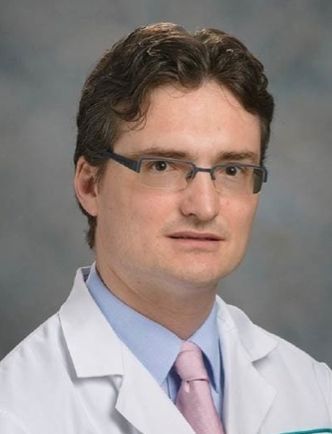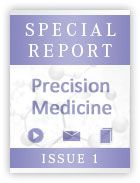KRAS Mutations Found in Urine of Advanced Cancer Patients With BRAF Mutations
Low-frequency KRAS mutations are present in urine cell-free DNA in about 80% of patients with advanced cancers and BRAF V600E mutations.
Filip Janku, MD, PhD

Filip Janku, MD, PhD
Low-frequencyKRASmutations are present in urine cell-free DNA (cfDNA) in about 80% of patients with advanced cancers andBRAFV600Emutations. These mutations can potentially drive resistance to BRAF-targeting agents, said Filip Janku, MD, PhD, at the 2015 ASCO Annual Meeting.
“We found some emerging data that even thoughBRAFandKRASwere deemed to be mutually exclusive, in some patients withBRAFmutations, you can actually find low frequency clones ofKRASin the cell-free DNA, which might potentially reflect tumor heterogeneity and the resistant clones, which might ultimately emerge because of selection pressure,” said Janku, from the Department of Investigational Cancer Therapeutics at MD Anderson Cancer Center in Houston, Texas.
The findings come from tracking cfDNA mutations in the urine of patients with refractory cancers. In the study, cell-free DNA was isolated from single or sequential urine samples from 34 patients with advanced cancers and archival tumor tissue, which tested positive forBRAFV600E. Cancer types included melanoma (n = 11), colorectal (n = 8), thyroid (n = 5), nonsmall cell lung cancer (n = 5), and other (n = 5).
Twenty-six patients were treated with BRAF-targeted therapy, one patient was treated with MEK-targeted therapy, and seven patients received no treatment. Patients had their urinary cfDNA evaluated forBRAFV600EandKRASG12/13at baseline and again while on treatment.
Cell-free DNABRAFV600Elevels were identified by mutant enrichment digital droplet polymerase chain reaction (PCR); cell-free DNAKRASG12/13mutations were monitored using a highly sensitive mutant enrichment next-generation sequencing assay. Analytical sensitivity ofBRAFV600EandKRASG12/13assays is 0.03% and 0.006% mutant alleles in wild-type DNA background.
Thirty-two of 34 patients (94%) withBRAFV600E mutation in the tumor also had detectableBRAF600E mutation in urine (mutant, n = 24; low-mutant, n = 8). In 25 of 34 patients (74%) analyzed longitudinally, changes in cfDNABRAF V600Ecopies correlated with percentage changes in target lesions on imaging (r = 0.68,P<.001). “Sampling in a longitudinal fashion showed that the number of patients withKRASmutations goes up as well as the number of detectedKRASmutations,” Janku said.
Urinary cell-free DNA was able to detect acquisition ofKRAS G12/13mutation in patients treated with BRAF- or MEK-targeted therapy. “Some patients had noKRASmutation detected before treatment but hadKRASmutations emerge on treatment,” Janku observed. “In some others,BRAFwent down even [in] patients who [weren’t] responding toBRAF-targeted therapy, simply by the fact that you block theBRAF-mutant cells from shedding into the circulation.”
“In 31 of 34 patients, we had enough DNA to doKRASmutation testing,” Janku said. Of the 31 patients tested for urinaryKRASG12/13mutations, 25 patients (81%) had low-frequencyKRASG12/13mutations (median 3.4 copies/105genome equivalents) on at least one test that were undetected in tumor samples by standard CLIA technologies; 11 patients had detectable urinaryKRASmutations pretreatment, and 19 patients had them while on treatment.
Seventeen of the 25 patients with urinaryKRASmutations were tested forKRASmutations in plasma, and 11 of these 17 patients (65%) hadKRASG12/13mutations.
Twenty-one of the 25 patients had KRAS tumor tissue testing; 20 patients had wild-typeKRASand one patient had aG13Dmutation. Eight samples were retested with droplet digital PCR, and one additional low-frequencyKRASmutation was found.
In a separate cohort of patients with tissue positive forKRASG12/13mutations, the number of total DNA fragments was found to be higher in urine compared with plasma samples.
“The question is what you’re going to do with this information,” said Janku. “I don’t think anybody has an answer for that. But to move this into the therapeutic setting, you have to understand it in the first place. The next step, once we figure out how we can monitor the clonal evolution, is to test acting on the information in clinical trials.”
Janku F, Vibat CR, Falchook GS, et al. Low frequencyKRASG12/13 mutations in urine cell-free (cf) DNA from patients withBRAFV600E-mutant advanced cancers.J Clin Oncol2015;(33 suppl). Abstract 11048.
<<<

Survivorship Care Promotes Evidence-Based Approaches for Quality of Life and Beyond
March 21st 2025Frank J. Penedo, PhD, explains the challenges of survivorship care for patients with cancer and how he implements programs to support patients’ emotional, physical, and practical needs.
Read More